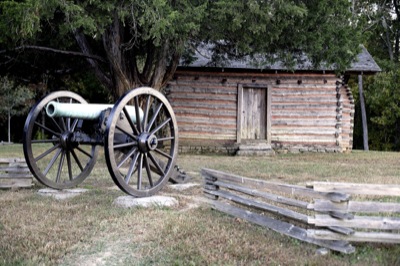
When the dust had settled and the smoke had drifted off, one thing became abundantly clear: The South would never again be the same. The Civil War left an indelible impression on the South as it did on the rest of the country.
Although citizens from throughout the then-young United States fought and died in the war, for Southerners the impact was especially deep, as the battles had been fought mostly in their own cities and fields.
It has been 150 years since the beginning of the Civil War. Although those who experienced it firsthand have long since passed, our memories of those four years of conflict live on. At battlefields, monuments and other sites throughout the South, today’s travelers can learn about the tragic and noble events of the war and how it redefined America.
From this year through 2015, many of these sites will commemorate the sesquicentennial of the Civil War. For groups traveling in the South, it presents a one-of-a-kind opportunity to relearn this pivotal time in American history.
Fort Sumter National Monument
Charleston, South Carolina
The Civil War officially began April 12, 1861, when Confederate artillery fired on Fort Sumter, a small island outpost in the harbor outside of Charleston. The fort surrendered 34 hours later and remained in Confederate control throughout much of the war.
Today, Fort Sumter National Monument is one of several cooperating parks sites in Charleston that give visitors an overview of the events leading up to the Civil War. Most visitors start at the Fort Sumter Visitor Education Center.
“They can see in our exhibit the stories that go from the foundation of our colony through the American Revolution and the dynamics of our Constitution up to the doorstep of the Civil War,” said Michael Allen, public information officer for the national monument. “The visitors center provides an opportunity to see what brought us to the war.”
From the center, a ferry takes groups on a 30-minute ride across the harbor to the fort. During the ride, passengers learn about Low Country culture, the African-American experience in South Carolina and the historical and political culture of the area. Upon reaching the island, rangers give guided tours of the fort, detailing the Civil War events that took place there.
Sesquicentennial commemoration events will take place at Fort Sumter April 7-17.
“We will have a series of programs that will help to tell the story of the war, not just from the battle side but also from the home front,” Allen said. “On different days, we will have soldiers there to tell the soldiers’ story. We’re also going to convey the message of what it was like in the community, on the plantation and in the daily life of a citizen.”
www.nps.gov/fosu
Manassas National Battlefield Park
Manassas, Virginia
The first major land battle of the Civil War took place near Manassas, Virginia, in July 1861.
“People lost not only their husbands and brothers, but both sides lost their innocence and ignorance about war,” said Gregory Wolf, a ranger at Manassas National Battlefield Park.
A second battle also took place at Manassas a year later. The two have come to be known as First and Second Manassas, or the First and Second Battle of Bull Run.
At the park, a visitors center gives a detailed overview of the two battles, including a detailed, colorful film narrated by actor Richard Dreyfuss. During a tour of the battlefield, visitors see a monument to Thomas Jackson, who earned the nickname “Stonewall” in battle there, and also learn about some of the civilians who lived in homes that are still preserved on the battlefield.
“There are two and a half buildings that date back to the war and a lot of other home sites and replacement structures dating back to the war,” Wolf said. “One is a stone building that was used as a field hospital. It’s furnished like a 19th-century tavern on the first floor, and there are artillery shells stuck in some of the pieces of stone.”
Sesquicentennial events will begin at Manassas on July 21, with living history, historic weapons demonstrations and a re-creation of the reconciliation of veterans that took place during the Peace Jubilee of 1910.
www.nps.gov/mana
Shiloh National Military Park
Tennessee and Mississippi
The largest Civil War engagement in the Mississippi Valley took place at Shiloh Church, near the Tennessee-Mississippi border, in April 1862. More than 23,000 men were killed or wounded during the two-day battle.
Shiloh National Military Park encompasses some 4,200 acres; the off-site Corinth Battlefield Unit in Mississippi protects another 240 acres. Visitors centers at both locations have exhibits on weapons and tools used in the battle, as well as information about the lives of people who fought in and were affected by the battle.
Tours at Shiloh include 20 stops at places such as Bloody Pond and the Hornet’s Nest. Groups can also take Civil War-themed tours of Corinth, Mississippi, during which they will see several miles of rifle pits, trenches and artillery positions that still exist around the city.
From April through October, living-history demonstrations take place at both park units. Sesquicentennial events this year include cavalry tactical maneuvers, encampments and historic artillery demonstrations.
www.nps.gov/shil
Chickamauga and Chattanooga National Military Park
Tennessee and Georgia
Crossing the border between Tennessee and Georgia, Union and Confederate troops fought battles at Chattanooga and Chickamauga in September 1863. The two-day encounter left the Union with a key position in Chattanooga.
Visitors to the National Military Park can get an introduction at visitors centers at either of the battle sites.
“When you come to the Chickamauga visitors center, we have a museum and a world-famous gun collection that spans from the beginning of weaponry to beyond the Civil War,” said interpretive supervisor Kim Coons. “At the Lookout Mountain visitors center, we have a painting that depicts the battle. It’s so large that the room that houses it had to be built around the painting.”
Groups can get a ranger-led step-on tour of the 5,300-acre battlefield. Throughout this year, they can also join in sesquicentennial commemorations that trace area events in 1861, such as the raising of the Confederate army.
In 2013, a large event will commemorate the battle that took place in the area.
“We’re going to do living history at a big event over a weekend in September,” Coons said. “We’ll do soldiers’ living history, and then we will do civilians and cover things that happened after the battle.”
www.nps.gov/chch
Olustee Battlefield Historic State Park
Sanderson, Florida
Tallahassee, Florida, was the only Southern capital not captured by the Union during the Civil War. The Union advanced from Jacksonville toward Tallahassee in February 1864 but was rebuffed by the Confederates in a battle at Olustee. The site of the battle is now preserved as Olustee Battlefield Historic State Park.
Groups visiting the area can take a guided tour of the battlefield, where they’ll see a monument dedicated by the Daughters of the Confederacy. A museum at the site has an introductory film as well as weapons, uniforms and other artifacts from the Civil War.
Many groups visit during the annual battle reenactment, which was chosen this year as a Southeast Tourism Society Top 20 event.
“We are the largest Civil War reenactment in the southeast United States,” said park services specialist Bob Giarda. “We have over 2,000 reenactors, who set up authentic camps of the 1850s period. There are vendors displaying wares from the Civil War period. It’s like stepping back in time to a Civil War camp.”
The centerpiece of the gathering is a re-creation of the battle scene with a skirmish between troops from the North and the South. Visitors can also attend a ladies tea, a period music concert, an author lecture series and other events over the course of the weekend.
The reenactment takes place each February; 2011 was the 147th anniversary of the battle. The park will commemorate the sesquicentennial in 2014.
www.floridastateparks.org/olusteebattlefield/
Southeast Tourism Society Tour Planner:
Welcome back to Southeast
Southeast Presidents
Southeast gardens
Southeast cuisine









